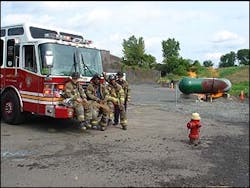National Run Survey: Busiest Heavy Rescue, Fire Station of 2006
For the 26th year, the career fire service takes to the pages of Firehouse Magazine to share and compare statistics about company and department activity levels, funding, staffing and pay. A total of 244 fire departments took part in this year's survey, representing 45 states, the District of Columbia and 8 Canadian provinces.
The departments represented in this latest survey protect 79,994,388 people, and they have budgets totaling more than $12 billion. They provide this service with 4,095 engine companies, 1,489 ladder companies, 1,826 ambulances and numerous other specialized units.
They respond to 1,623,691 fire calls, 7,284,434 EMS calls and 10,757,152 total calls last year.
Hartford, Conn. Busiest Heavy Rescue
Hartford Fire Department's Heavy Rescue came out on top this year in Firehouse Magazine's National Run Survey.
In 2006, the specially trained rescue personnel went out the door 4,820 times to assist with a myriad of incidents.
Training for those tasks is essential because the technicians never know what challenges the next call may bring. It could be a water rescue, a person trapped in a confined space or a construction worker dangling high above the city.
It's considered an honor to get assigned to Tac 1, and there's a lot of hard work and sweat required as the team hones their skills almost daily. The majority stay there until they get promoted or retire, said Capt. Frank Costello, who recently transfered to the training division after a five-year stint with the squad.
The captain said he's still involved in the tactical aspect at the training division. Costello said it's imperative that firefighters take every opportunity to hone their skills. "You never know what you'll face when the alarm sounds."
The team is dispatched on all calls except for EMS. They report to the incident commander, and at a fire join other firefighters in search and rescue. One crew also stands by as RIT.
Their unit is equipped with various extrication tools, generators, portable lights, rappelling equipment, SCBA cylinders, airbags, thermal imaging cameras and other things necessary for their unique work.
The firefighters at Tac 1 also are involved in handling hazmat incidents and mishaps that occur on the water. The department has a 22-foot Sea Ark that can be used as a fire boat as well as in rescues, Costello said
Acting Deputy Chief Bill Call said the department operates its own training academy, and holds periodic exercises to put firefighters through the paces.
Their safety as well as public safety depends on correct decision making.
Call said Tac 1 has responded to 2,478 incidents so far this year, and is on track to capture the top spot once again.
"This is a very important unit in our department," Call said. "They take their work seriously."
Los Angles City Station 9, Busiest Station
With over 22,000 runs, Los Angeles City Fire Department's Fire Station 9 earned Firehouse Magazine's title of busiest station.
Situated in one of the city's rougher areas, Captain Edward Hengst said that although most of the calls they get are EMS-related, there is no 'normal' for he and his firefighters.
"This area is saturated with people who are transients, and many of the public service organizations are oversaturated," he said. That means he and his crew must learn how to treat people who, in many cases, are sick, addicted to drugs, or suffering from mental illness.
Because of their high volume of calls - Station 9 is a little more well-equipped than the average fire station. Hengst said that instead of just one fully staffed engine, they have two. And each of those run about 20 calls each every day.
"My first day here, I ran 28 calls," he says.
The station also has two paramedic ambulances, which also feel the brunt of the busy station's burden.
"They get trashed, too - they get beaten."
Crewmembers serve as both firefighters and paramedics and they rotate between the two jobs, serving an engine assignment one day, and rescue assignment the next. They work 24-hour-shifts, and work about 10 shifts a month.
Most of the calls station nine gets are not far -- basically within a mile of the station.
"We can get there fast, take care of business fast and as soon as we clear -- boom -- the next one.
With so much to do, Hengst said, there has been talk of relocating another firehouse to cover some of the service area.
"It's always going to be a money issue," he said. Funds are hard to come by, so firefighters can't depend on additional resources.
However, he said stations in surrounding areas have stepped in to handle calls when the station is especially swamped.
Working such long hours under such extreme circumstances can wear on anyone, and Hengst said firefighters at station 9 work hard to keep themselves sane and healthy.
"The one thing you have to deal with most is our own safety. We go in and try to have a positive attitude." The 23-year veteran also speaks highly of the firefighters that he works with - saying the attitude they have is remarkable.
"The entire crew on my shift is young guys with great attitudes."
Hengst, who has spent the bulk of his career at busy stations, had some other words of advice:
- "Limit the overtime that you work."
- "You've got to think positive thoughts -- if you're negative that's going to go out into the field."
- "Vent to crew - we understand because we're all in the same boat."
